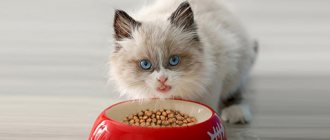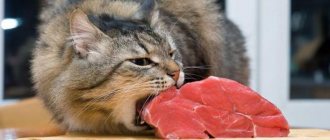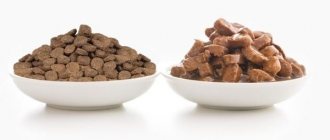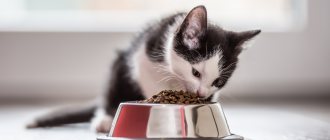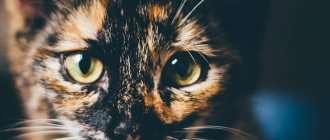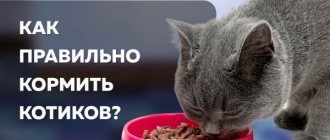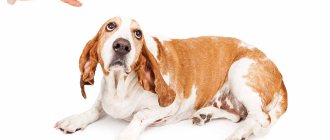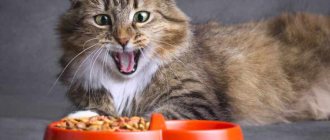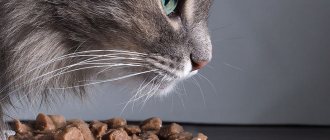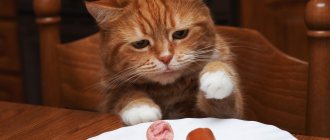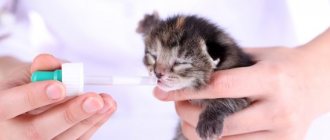February 3, 2020
The health and longevity of a cat largely depends on the quality and balance of its diet - some owners rely on the world experience of veterinarians and breeders, choosing to feed industrial diets, while others remain faithful to the traditional, natural type of feeding, taking responsibility for the balanced nutrition of the pet into their own hands. So what is better to feed a cat, natural food or dry food?
Ready-made food versus homemade food
A properly formulated diet is the key to the health of your pet.
Pet breeders are divided in their opinions regarding the proper feeding of cats and kittens.
Some argue that the animal should be given only natural products without “store food”; others argue that a homemade diet does not contain those beneficial additives that are included in industrial food.
It really doesn’t matter what kind of food a breeder gives his pet –.
The main criterion is a balanced diet.
The diet should contain:
- vitamins and minerals;
- macro- and microelements;
- proteins;
- fats;
- carbohydrates.
Ready-made meals have a number of advantages:
- The owner does not waste time preparing food. Industrial feed is sold in packs or small packages that are designed for one use.
- Dry food can be left for several days. It does not deteriorate and is a “lifesaver” in case of a long absence of the breeder.
- Luxury and holistic food contains all the components necessary for proper nutrition of the pet.
- A wide range of products will allow the owner to choose food specifically for his animal, based on individual needs. There are lines of food for cats of different ages, sterilized pets, lactating cats, animals with various diseases, excess weight, etc.
The disadvantages include the pricing policy . High-quality food of premium class and higher costs more than natural food. Buying economy class food is strictly not recommended. They negatively affect the health of your pet.
Pros and cons of natural food for cats
| + | — |
| Relative naturalness, maximum proximity to the cat’s natural diet | Expensive |
| You know and see exactly what you feed your cat | It takes a lot of time to buy food for your cat and prepare it correctly. |
| Looks delicious for a cat | It's difficult to properly balance a cat's diet |
| Provides proper load on teeth | It is necessary to give a complex of vitamins, which is also difficult to choose |
| Contains enough moisture | You need to follow a feeding schedule |
What is a natural diet?
Natural diet - balanced nutrition
Natural diet - balanced nutrition , which includes meat and fish products, eggs, boiled vegetables, milk and dairy dishes.
Such nutrition is necessary for the full development of the cat. Thanks to these products, the body receives micro- and macroelements, calcium, protein, vitamins and minerals.
Basic diet
The basis of nutrition is natural meat, fish and fermented milk products.
Main dishes:
- Meat, offal and fish. To prepare meat dishes, you should choose low-fat varieties, namely: beef, rabbit, chicken, veal. Of the by-products, light ones are especially popular, but they should be given in small portions, after boiling for 2-3 minutes. Many breeders buy beef tripe, but it needs to be stored in the freezer for several days before using it.
- Boiled eggs. An adult pet needs 1-2 eggs per week.
- Dairy products. They are necessary for the animal to improve the functioning of the digestive system, and also saturate the body with calcium. Fresh milk is difficult to digest; it should be given several times a week in small portions.
- Boiled vegetables. They saturate the pet's body with fiber. If the animal refuses to eat them in their pure form, the product is mixed with fish or meat.
- Root vegetables and fresh herbs. Helps improve the digestive system and saturate the body with fiber.
- Cereals: rice, buckwheat porridge.
Be sure to read:
How to fatten a cat: when weight gain is required, methods of fattening, what to feed, what not to do
What should not be in a natural diet?
It is strictly forbidden to feed your pet food from the table. What a person considers a “treat” harms the cat and leads to the development of diseases.
Prohibited ingredients:
- sausage;
- pork (difficult to digest product).
- sweets (sweets, cookies, cake);
- mushrooms;
- fried, smoked dishes.
Veterinarians remind that meat should be given after heat treatment. In its raw form, it will be harmful to your pet, as it may contain hormones and antibiotics.
It is forbidden to give pork liver as an offal. It causes difficulty in bowel function and the pet may develop diarrhea.
Cons of homemade food
Your pet needs a complete, balanced diet.
When choosing a “straight” breeder, the breeder faces a number of problems, namely:
- The need to maintain proportions. The daily rate is calculated based on the weight of the cat, 40-50 g per 1 kg of body weight. Meat – 55%, offal – 25%, fiber – 10%, vegetables – 10%.
- The need to give a vitamin complex. Vitamins are prescribed, as a rule, twice a year.
- Search for quality meat products. You should only buy meat from trusted stores to avoid poisoning your pet.
- Problems with giving vegetables. The cat may refuse mash with the addition of boiled foods.
- Selection and preparation of fish. Only sea or ocean fish are given raw; freshwater fish must be boiled and the bones removed.
- Choice of milk. Dairy products must have at least 10-15% fat content.
Incorrect nutrition or low-quality products will affect the health of your beloved animal.
Let's understand the concepts
Sometimes people mean completely different things by the same word or phrase. Therefore, the first thing you need to do is decide on the terminology.
"Natural"
Everything seems to be clear and understandable here: “natural” is a generally accepted abbreviation among pet owners for the phrase “natural food.” It is a diet consisting of fresh foods, which can be either raw or boiled or stewed.
In practice, owners call a wide variety of food types natural:
- dishes from the human table, including bones, scraps;
- porridge prepared especially for cats, mixed with meat or canned food;
- meat and other sources of animal protein with a small addition of plant foods;
- special canned cat food, which is available in pouches and cans.
Let’s make a reservation right away: the first two points have little to do with a cat’s healthy diet. Dishes from the human table are oversaturated with salt and spices, and often contain a lot of carbohydrates, like the porridges below.
Cats are obligate (that is, strict) predators. Unlike facultative predators, they are not able to survive without meat products. Therefore, only the option where meat, fish and eggs form the basis of the diet (from 70–80%) can be considered the correct “natural food”. Plant products are added only as a source of fiber: a cat can obtain all essential nutrients, including vitamins, from animal food, if it is presented in sufficient variety.
Special canned foods are also acceptable, provided they have a good composition. However, calling them “straight” is a mistake. This is still the same industrial food, but containing significantly more moisture compared to dry food. The remaining ingredients are usually similar.
Dry food
This concept includes products that are very different in quality and composition. If the finished diet consists of more than half grain, then it is little better than the cereals discussed above. This food is suitable only for birds, but not for cats.
When deciding what to feed your cat - natural food or dry food, you should consider only high-quality meat-based products. Acana Cat and Orijen Cat ready-made diets are created according to the principle of biological conformity, which implies maximum approximation to the nutrition of cats in their natural habitat. In practice, this means that dry food consists of 75–85% meat ingredients, most of which enter production fresh (without prior freezing) and raw. This is achieved by purchasing raw materials from local farmers and fishermen.
In addition, during the development of the Acana Cat and Orijen Cat formulas, great attention was paid to the Whole Prey concept, which translates to “whole prey” in English. Along with muscle meat, cartilage tissue, small bones, and internal organs of herbivores and birds are added to the composition. All this is necessary for the cat to receive vitamins, minerals and other valuable microelements in an easily digestible form - just as it would be in nature.
Ready-made food: diet and nuances
It is worth buying industrial food only of good quality. This is premium, luxury, holistic food. A cheap product will have a detrimental effect on the health of the animal; it is made from low-quality products.
The diet depends on the age and mobility of the pet. An adult cat is fed 2 times a day, morning and evening. If a pet leads a calm lifestyle, 40-60 g of dry food is enough for him; for active animals, a single meal reaches 80 g.
Be sure to read:
Food for sphinxes, what to feed a kitten and an adult cat: menu by month
Kittens are fed 3-4 times a day in small portions. Additionally, boiled milk is added.
Dry food
Dry foods include:
- meat;
- vegetables;
- cereals;
- offal;
- necessary nutrients.
Croquettes are prepared from the mixture, adhering to the temperature regime. Dry food does not contain moisture; the animal must have clean boiled water.
Dry food is chosen by breeders who are forced to leave their pet alone unattended. Such food will not spoil quickly, and the animal will not starve. The benefits of food include cleaning the mouth. Croquettes help clean teeth and prevent plaque.
If the animal cannot chew dry food thoroughly, it is soaked in water.
Inexpensive food contains ground bones, feathers or intestines, so such food contributes to the development of urolithiasis, causes an allergic reaction, kidney and liver diseases.
Norm of dry food per day
Dry food is chosen by breeders who are forced to leave their pet alone unattended.
The amount of food is calculated based on the weight of the pet.
Daily food intake for an adult cat:
- body weight up to 3-4 kg – 40-60 g;
- body weight 5 kg – 60-80 g;
- body weight from 5 kg - calculated proportionally: 10-12 g of feed per 1 kg.
For kittens:
- weight less than 2 kg – 40 g;
- weight 2-3 kg – 50-55 g.
For older cats, the daily allowance is slightly reduced. Pregnant cats are given 60-70 g of dry product per day.
In case of illness, the daily dose is prescribed by the veterinarian. A castrated animal is fed 3 times a day in small portions, as they are prone to gaining excess weight.
How much wet food do you need per day?
The label indicates the manufacturer's recommendations on how much food to give to your pet. Depending on the company, the quantity of the product may vary slightly.
If the manufacturer does not indicate the daily norm, you should calculate it yourself:
- body weight less than 2 kg – 120-150 g;
- weight from 3 to 5 kg – 200-250 g.
The daily intake of wet food should not exceed 7% of the animal’s total body weight.
An adult pet should be fed twice a day - morning and evening, dividing the daily amount of canned food equally. The interval between meals does not exceed 9 hours.
Flaws
Wet food is a balanced diet for your pet.
But the breeder should pay attention to a number of disadvantages of such nutrition:
- High price. Wet food costs much more than dry food. If breeders have several pets, the purchase of food will affect the family budget.
- Quick spoilage. The product quickly becomes weathered; the cat may refuse to eat canned food if it has been in the bowl for a long time and has dried out.
Be sure to read:
Development of kittens by weeks and months: how they grow, look, until what age is considered a kitten
When choosing a product, you should carefully study the packaging. High-quality food is marked as complete food. If this is not the case, the product is made from low-quality ingredients and is not suitable for the animal.
General information about natural feeding
High-quality natural feeding requires balance, a low amount of carbohydrates and the complete exclusion of dangerous foods. Cat food needs to be prepared separately, every day or every other day. Most pets are good at eating chopped raw (processed with boiling water) foods.
General rules for natural feeding are as follows:
- The bowl must be clean - food should not be left in the bowl for the cat to eat later. After each feeding, the bowl should be removed and washed.
- Food should be warm - warm food has a more attractive aroma and is better digestible.
- Regular weighing and adjusting the diet depending on the season of the year.
- The presence of coarse fibers in the diet - vegetables, grass, fruits.
- Regular courses of vitamin supplements.
- The basis of the diet is protein products.
Meat is the basis of a cat's diet. Your pet cannot eat fresh meat; it must be kept in deep freeze for at least 3-4 days. Try to buy beef for your cat. To dilute the diet, you can use chicken, turkey, quail, and rabbit. In addition to meat in its natural form, a cat has a need for offal: heart, liver.
Cats are not allowed fat, skin, bones, beaks, claws, raw pork, lamb, duck, goose. To prevent tartar, your pet can be given soft cartilage.
Milk and fermented milk products are an additional source of protein and “building material” for the skeleton. Some adult cats are lactose intolerant, so whole milk is excluded from their diet. You can safely include in your diet:
- Ryazhenka, kefir, yogurt.
- Low-fat sour cream and calcined cottage cheese.
- Homemade yogurt.
- Unsalted varieties of hard cheeses and feta cheese.
Fish and seafood – Domestic cats should be given fish, but not on a regular basis. Noble varieties of fish, only oceanic and low-fat, are suitable for feeding your pet. Fish should absolutely not be given raw; it must be well boiled and cleaned of bones.
Many cats love shrimp, squid and other seafood. There are no prohibitions on including these products in your pet’s diet. However, it is important to remember that seafood is an unnatural food for your pet; it is rich in salts and microelements.
Raw fish is a source of infection with very dangerous types of parasites, the primary invasion of which is asymptomatic.
Chicken and quail eggs are a source of protein, animal fat, vitamins and microelements. Cats are allergic to chicken eggs, but there are no contraindications to quail eggs. It is important to understand that if you feed eggs too often, your cat may develop an allergy, even if the pet has not suffered from it before.
Vegetables and grass are a very important part of a cat's diet. Without coarse fibers, the digestion process is disrupted, that is, the meat that a cat eats is not digested, but rots in the intestines. There is no need to give your cat too many vegetables; it is better to mix them with cottage cheese or meat. Plant grass for your pet, then he will be able to “clean” his stomach on his own and compensate for his needs for hard fibers.
Grains in a cat's diet are a controversial product. For cats with allergies, food based on rice or buckwheat is often suitable. It is better to exclude wheat and other high-calorie cereals from the diet.
Mixed feeding – harm or benefit?
Some breeders decide to use mixed feeding. This diet involves the simultaneous consumption of ready-made food and natural food.
Such feeding will do more harm than good:
- The intestines digest natural food after 1.5-2 hours have passed. At this time, the finished product is in the pet’s stomach. This process has a negative impact on the digestive system.
- Any mixed diet will eventually lead to diseases of the digestive system.
Breeders note that when mixing feed, the animal may completely abandon natural ingredients.
About mixed feeding
Many owners feed their pets dry food and meat until they are faced with the opinions of experts. Indeed, veterinarians and breeders do not recommend mixing food types , as this can lead to dysbiosis. The main reason is that the cat's digestive system gets used to working in a certain way and it is difficult for it to adapt.
Dry food begins to be digested within 1-2 hours after swallowing. The fact is that the granules are saturated with water and only after that moves into the intestines. Natural food is quickly processed by acids in the stomach and begins to be digested in the intestines. Dry food remains in the intestines for 4–6 hours, since the granules quickly disintegrate into a homogeneous pulp. Natural food, digests up to 8 hours. Judge for yourself how quickly the body will have to adapt if feeding is mixed.
Quite often, owners mix the granules with broth to soften them a little. There is nothing wrong with this approach, but it is worth remembering that eating only soft food leads to rapid tooth decay. It is not recommended to mix dry food granules with natural products in one meal, since such a treat will not be digested and will cause a fermentation process in the intestines.
In what cases is industrial food better than natural food?
There are several points when it is better to replace natural products with industrial food:
- The owner is often not at home . Natural ingredients spoil quickly, especially in hot weather. If the breeder has an automatic feeder, it is necessary to use only industrial feed. This option is suitable for those people whose work requires travel.
- A person has a spayed or neutered cat. Manufacturers have taken care of pets by creating a specialized product that contains all the necessary substances and does not contribute to excess weight gain. At home, it is important to carefully select ingredients without disrupting metabolism. The amount of carbohydrates is reduced by 30%.
- The cat is sick with something. For animals with diabetes, kidney disease or urolithiasis, special lines of food have been developed taking into account the need for vitamins and minerals. It is difficult to maintain such a diet at home.
For any illness, it is important to consult a veterinarian; he will prescribe a diet.
How to make a choice?
When choosing between natural and dry food, you need to think not about your own convenience, but about the needs of the cat. Your pet is a carnivore and cannot thrive if it does not get enough protein.
Wild cats eat meat and natural products; it is advisable that the domestic cat receives a similar diet. Industrial feed can and should be considered as an alternative for a number of reasons. Not all owners have the time to cook for their cat every day. One of the options for natural feeding is preparing canned meat and vegetables. Dry food is definitely better than table scraps or stale food...as long as the food is of good quality.
Many owners are faced with illnesses of their pets and the need to keep them on a diet for life. If you have diabetes, cats should not eat carbohydrates, if they have urolithiasis, they should not eat salt, or if they have allergies, there is quite a wide range of unsafe foods. In this case, medicinal or hypoallergenic food is a worthy, and sometimes the only, alternative.
Some breeds are prone to urolithiasis and owners are afraid to sterilize them. In this case, veterinarians suggest switching the cat to special food for castrated and sterilized animals. This type of food belongs to the holistic or super-premium class, not medicinal.
The connection between urolithiasis and castration or sterilization has not been officially confirmed.
Natural nutrition is definitely healthier if the quality of the products is not in doubt. Think for yourself, how natural are the products you buy in the store? Meat from animals raised on hormonal drugs, milk from powder, cottage cheese from starch? If you do not have the opportunity or desire to purchase high-quality food, then industrial, balanced food would be a safer option for your cat.
Balanced feeding of a cat includes meat, offal, coarse fibers, oils, vitamins and microelements. You will notice that there are no cereals or cereals on the list, and this is correct, since a healthy cat does not need additional carbohydrates. Quite often, owners of cats and dogs feed their pets the same porridge... and in this case, it is better for the cat to buy high-quality industrial food (without carbohydrates).
Dry or canned food?
Dry food is suitable for animals that do not have problems with
health and drink enough water. Canned food is suitable for almost everyone (you should not store an open can in the refrigerator for more than a day).
Give food at room temperature. Always check the expiration date. Do not buy dry food by weight (it may lose many properties). Make sure your cat always has access to water.
For a number of reasons, dry croquettes are preferable to canned ones. Firstly, canned food loses its flavor and other properties faster and is more difficult to store. Secondly, canned food is 80% water. Therefore, to satisfy the cat’s needs, you will need much more of it than dry food. Thirdly, using canned food is much more expensive than dry food. You can give wet food from time to time. Hard kibble helps clean and strengthen your cat's teeth.
Feed classes
Depending on the composition and price, all cat food is divided into 4 classes: economy, premium, superpremium and holistic. Moreover, according to experts from the popular portal “Petobzor,” which specializes in reviews of pet products, in some cases, super-premium products can cost less than premium ones.
Economy
Everyone is familiar with this class of food from television advertising. Yes, Whiskas, Kitekat, Felix and others like them are economy class, suitable for not too frequent use or as a travel option (keep bags in your pocket for starving street cats). The protein base is by-products, and to a lesser extent, meat.
These foods contain wheat, soy and corn flour, and may contain flavor enhancers and preservatives. On the other hand, products from economy-class brands can be found in any nearby supermarket, but for premium-segment or holistic-class food you will have to go to a pet store or veterinary clinic.
The most popular economy class brands: Whiskas, Kitekat, Felix, Purina One, Night Hunter, etc.
Premium
Premium food is of good quality and contains 25–30% meat or offal, vitamins, and minerals. Products of this class contain less “ballast” - soy, corn and other carbohydrates, and there are no flavor enhancers or dyes. They are sold both in specialized stores and in supermarkets.
Popular premium food brands: Royal Canin, Hill's, Gemon, Brit, Pro Plan, Sheba, Iams and Gourmet.
Superpremium
Balanced feed with sufficient minerals and vitamins. Meat content is at least 25%, and most of the protein is represented by meat, and not by-products. Cereals: rice, oatmeal, barley, etc. There are separate lines for cats with special needs and for the prevention of diseases.
Super premium food: Pronature Original, Gina, Bozita, Flatazor, 1st Choice, Bosch, Organix, Schesir, Brit Care, Leonardo, Monge.
Holistic
The most expensive foods sold in pet stores and veterinary clinics. They contain at least 50% natural meat without the addition of offal. It also contains legumes, vegetables, fruits, healthy herbs and even berries.
Popular holistic foods: Innova, Acana, Almo Nature, Farmina N&D, Pronature Holistic, Orijen, Gina Elite, Grandorf, Barking Heads, Savarra, Go!, Now, SUPERPET.
Composition of cat food
What must be included
- Animal protein (at least 20–22%, ideally at least 35%): fresh or dried (dehydrated) poultry, beef, veal, rabbit, and in very rare cases, pork.
- By-products (at least 10%): liver, heart, etc. The exact ratio of by-products must be indicated on the packaging.
- Plant carbohydrates (minimal content): rice, barley, oats and legumes.
- Plant fiber (no more than 25%): herbs, vegetables, fruits. Carrots, zucchini, pumpkin, broccoli, asparagus, cucumbers, celery, beets, green beans, parsley, dill, lettuce, and sprouted grass are safe.
- Vitamins and minerals: taurine, vitamin B, E, unsaturated acids omega-3 and omega-6, calcium, potassium, amino acids.
- Rosemary extract as a natural preservative and antioxidant.
What should be the minimum
- Cereals and legumes: wheat, corn and soybeans. As a rule, they are used to “fill” inexpensive feeds, replacing them with other products in the premium segment.
- Synthetic preservatives E320 and E321, as well as flavoring additives.
700 rub.
Dry cat food Gemon Cat “Chicken and Turkey”, 1.5 kg
1 review
38 rub.
Wet food for kittens Mnyams “Tender pieces with lamb | Farmers' Fair", 85 g
0 reviews
69 rub.
Wet food for cats Gemon Cat Pouch “Beef pieces with vegetables”, 100 g
0 reviews
242 rub.
Dry cat food Gemon Cat Sterilized “Turkey”, 400 g
0 reviews
242 rub.
Dry cat food Gemon Cat Urinary “Chicken and Rice”, 400 g
0 reviews
441 rub.
Kitekat wet cat food “With rabbit in sauce”, 85 g x 28 pcs.
0 reviews
1024 rub.
Dry cat food Mnyams Hairball&Indoor “Lamb”, 1.5 kg
0 reviews
441 rub.
Kitekat wet cat food “With chicken in sauce”, 85 g x 28 pcs.
0 reviews
Food for your cats on TEA.ru
What is strictly forbidden
- The following vegetables: potatoes, eggplants, tomatoes, avocados, onions and garlic, rhubarb, sorrel (can cause severe poisoning). Grapes, raisins, and persimmons are also toxic to cats.
- Cocoa beans, cocoa, chocolate. They contain theobromine, which is incredibly beneficial for humans, but very dangerous for cats.
- Salt.
Features of the diet of some breeds of kittens
In general, feeding kittens of all breeds is the same and all nutrition components are identical. But representatives of different breeds have anatomical features and genetic predisposition, so there are still small nuances in feeding.
What is the best way to feed British kittens?
British Shorthair kittens have an increased need for animal proteins due to their constitution, and also have a tendency to gain extra pounds, which is fraught with health complications and requires careful attention to the organization of their diet from a very early age. Handouts from the table are excluded, and the daily food intake is strictly monitored.
Scottish kittens
Scottish fold kittens tend to straighten the plane of the ear, so the level of calcium in their diet is controlled: they do not give milk (which is not necessary for other breeds of kittens), limit foods high in glucosamine (in natural diets these are cartilage and fish heads).
If the owner has opted for industrial food, then it is easier to choose a brand that specializes in the breed characteristics of cats, the line of which includes a representative of a certain breed. A consultation with an experienced expert felinologist or veterinarian will also help, who will advise how to make the food for your ward complete and healthy.
